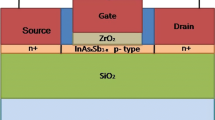Abstract
The optimum biasing points and structural design parameters for novel nano-scale double gate MOSFET (DG-MOSFET) radio frequency mixers are investigated at 2.4 GHz. Our objective is to analyze and identify the correlation of the conversion gain of the mixer circuit with the signal amplitude of the local oscillator (LO) as well as different device parameters, such as the gate length (L gate ), doping concentration (N A ) and body thickness (t Si ), thus minimizing signal loss and power consumption and increasing stability. The most important figure of merit is found to be the LO DC bias that determines the level of non-linearity in the transconductance response. Furthermore, we observe that in properly designed DG-MOSFETs \((\hbox{L}_{gate} \ge 3t_{Si}),\; \hbox{L}_{gate}\) and N A have limited impact on the conversion gain of the mixer, while t Si has a more significant role to play. Although the mixing performance of DG-MOSFETs is ultimately limited by the short channel effects perpetrated by any given structural constraint, an optimum body thickness t Si exists in each case to maximize the conversion gain. Thus, we illustrate how 2D and quantum-corrected simulations can identify the optimum body thickness and optimum bias conditions in such compact nano-scale mixers.















Similar content being viewed by others
References
Skotnicki, T., Hutchby, J. A., King, T.-J., Wong, H.-S., & Boeuf, F. (2005). The end of CMOS scaling. IEEE Circuits and Devices Magazine, 21, 16–26.
Ahmed, K., & Schuegraf, K. (2011). Transistor wars. IEEE Spectrum, 48, 50–66.
Ferain, I., Colinge, C. A., & Colinge, J. -P. (2011). Multigate transistors as the future of classical metal-oxide-semiconductor field-effect transistors. Nature, 479,310–316.
Kim, J.-J., & Roy, K. (2004). Double gate-MOSFET subthreshold circuit for ultralow power applications. IEEE Transactions on Electron Devices, 51, 1468–1474.
Amara, A., & Rozeau, O. (2009). Planar double-gate transistor. Dordrecht, Netherlands: Springer.
Lazaro, A., & Iniguez, B. (2006). RF and noise performance of double gate and single gate SOI. Solid-State Electronics, 50, 826–842.
King, T.-J. (2005). FinFETs for nanoscale CMOS figital integrated circuits. In IEEE/ACM International Conference on Computer-Aided Design (pp. 207–210).
Fossum, J. G. (2004). UFDG users guide (Ver. 3.0). Gainesville, FL: University of Florida Press.
Kaya, S., Hamed, H. F. A., & Starzyk, J. A. (2007). Low-power tunable analog circuit blocks based on nanoscale double-gate MOSFETs. IEEE Transactions on Circuits and Systems II, 54, 571–575.
Huang, S., Lin, X., Wei, Y., & He, J. (2010). Derivative superposition method for DG MOSFET application to RF mixer. In Asia Symposium on Quality Electronic Design (ASQED) (p. 361).
Reddy, M. V. R., Sharma, D. K., Patil, M. B., & Rao, V. R. (2005). Power-area evaluation of various double-gate RF mixer topologies. IEEE Electron Device Letters, 26, 664–666.
Zhang, W., Fossum, J., Mathew, L., & Du, Y. (2005). Physical insights regarding design and performance of independent-gate FinFETs. IEEE Transactions on Electron Devices, 52, 2198–2206.
Taur, Y., et al. (2004). A continuous, analytic drain-current model for DG MOSFETs. IEEE Electron Device Letters, 25, 107–109.
Reyboz, M., Martin, P., Poiroux, T., & Rozeau, O. (2009). Continuous model for independent double gate MOSFET. Solid-State Electronics, 53, 504–513.
Lee, T. (2004). The design of CMOS radio-frequency integrated circuits. Cambridge, UK: Cambridge University Press.
Razavi, B. (2012). RF microelectronics. Boston, MA: Prentice Hall.
Maiti, T. K., & Maiti, C. K. (2010). Technology CAD of nanowire FinFETs (Ch. 20). Rijeka, Croatia: INTECH.
Razavi, B. (2001). Design of analog CMOS integrated circuits. Boston, MA: McGraw Hill.
Author information
Authors and Affiliations
Corresponding author
Rights and permissions
About this article
Cite this article
Laha, S., Kaya, S. Bias optimization of 2.4 GHz double gate MOSFET RF mixer. Analog Integr Circ Sig Process 77, 529–537 (2013). https://doi.org/10.1007/s10470-013-0164-1
Received:
Revised:
Accepted:
Published:
Issue Date:
DOI: https://doi.org/10.1007/s10470-013-0164-1




